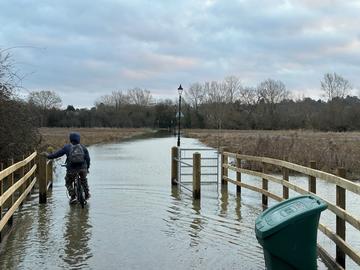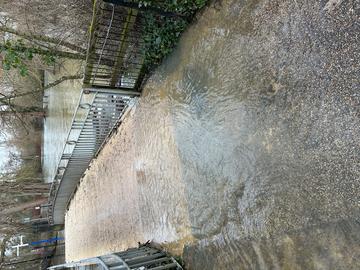WATERY OXFORD

WATERY OXFORD
Widespread flooding has changed the appearance of Oxford
Published: 9 January 2024
Author: Richard Lofthouse
Share this article
The second week of the New Year has seen Oxford deluged by flooding, judged the worst since 2007. Dozens of flood warnings were in place across both city and county while the submerged Abingdon Road remained shut to through traffic, causing significant additional traffic congestion around the ring road.
Sunday 7 January even saw an impromptu visit to Osney Island by the Prime Minister Rishi Sunak (Lincoln, 1998).
The far end of the Botley Road was also submerged and the adjacent Seacourt Park and Ride became a great sea during Friday January 5, after heavy rain on already soaked terrain - and remains shut.

QUAD headed out on the significantly cold day of January 9, evaded the path closed signage and entered the strangely transformed landscape of Mesopotamia - the footpath between South Parks Road and Marston so popular with walkers and cyclists as a picturesque route into the city (pictured, right).
The River Cherwell has not only flooded a significant corner of the University Parks but is up to the top of the various foot bridges, so that were you to be on an out of control punt, you would be aiming to go around the bridges rather than under them, currently an impossibility (see below, Lemond Bridge, 9 January, 2024).
Meanwhile, Port Meadow is truly the inland sea that most alumni may remember seeing at some point.
Many businesses and householders have been negatively affected and there is a broader discussion about both flood resilience and management - and climate change.

According to local group Oxford Rivers Network, which monitors the Cherwell and Thames for water quality, the Oxford area been identified as an 'important freshwater area' for its freshwater biodiversity. Its floodplain meadows are protected nationally as a 'special area of conservation'. Yet despite this, its rivers and waterways are in a bad state, with only 2 out of 48 waterbodies classed as in good ecological health (4%).
Aside from these concerns the landscape has become temporarily eery in areas where paths and roads have been closed, returned for a short moment to nature and a reminder that humans aren't the only players in the natural cycle.
Recently opened at Oxford's Natural History Museum on Keble Road, is Fair Water, a year long exhibition about global water equity.
The exhibition tells the story of the complex journey taken by our water, from river source to mouth, rainfall to drinking glass – a process easily taken for granted in the UK. Through the lens of communities in Kenya, Ethiopia and Bangladesh, the exhibition examines current approaches to water management and how communities and engineers are working to provide access to drinking water and protection against hazards like floods and droughts.
FAIR WATER? The Inequality Below the Surface, 21 November 2023–1 September 2024















